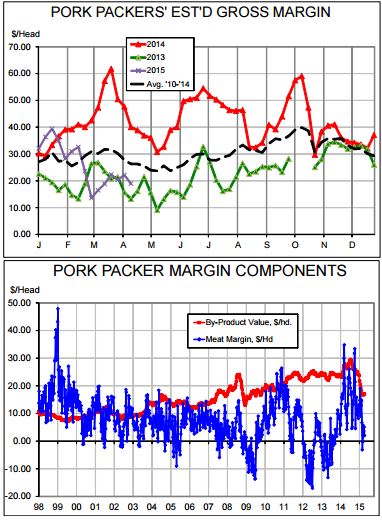



CME: Low Pork Prices Not Yet Reaching Consumers
US - Cheaper, and many would argue downright “cheap“, hogs have been of little solace to pork packers this spring, write Steve Meyer and Len Steiner.While the cost of the primary production input for a packing plant has been less than half the amount of one year ago in recent days, packer margins are still struggling.
As with virtually anything in the pork sector, any comparison to one year ago pales but packers’ gross margins have been well below the 5 year average for the past two months and, given the continued struggles of the margin components, are showing little sign of improvement.
The one solace is that relatively large hog numbers have kept unit costs low, the complete opposite of one year ago when very low throughput drove unit costs higher.
Those $50 per head gross margins were certainly profitable but not nearly as profitable as one might think after plant and labour costs were spread over so few animals.
A primary culprit this year, though, has been the huge reduction in the value of “by-products.” These items are, generally, those parts and pieces of the pig that are not sold (or not sold in very large quantities) in traditional American meat counters.
They include most organ meats such as livers, hearts, kidneys, stomachs, chitterlings, etc., head products, lard (both edible and inedible), meat and bone meal and blood products.
Meat and bone meal is used in animal and pet diets but has fallen into some disfavour as both livestock producers and pet owners have moved toward more “vegetarian” diets. We still aren’t convinced of the concept of vegetarian dogs and cats but we suppose they eat what their owners put in front of them, right?
Porcine blood plasma has for many years been a key component in weaned pig diets but it fell into some disfavour last year due to suspicions that it was a vector for spreading PEDv.
Many of these “by-products”, especially the organ meats and head products such as snouts and masks, it is no surprise that the drop in the by-product value from nearly $30 per head last summer to just $16.90 per head last week corresponds to the sharp rise in the value of the US dollar.
Add that factor to larger supplies and difficulties in getting product off our West Coast ports and you have a decidedly unsavoury recipe for total value. The reduction would account for about $6/cwt. carcass of the decline in hog value.
As can be seen in the graph, the “meat margin” held up reasonably well into February but actually went negative early March and has improved only slightly since then. The larger freezer inventories we discussed previously will keep those margins under some pressure in the short term.
Further, the seasonal decline in hog numbers is hardly ever conducive to packer margins. The degree to which that happens this year is in some question but even though numbers will be much larger than last year, they will still decline seasonally, likely keeping meat margins very tight.
A good solution to all of these woes would be a rally in wholesale pork cut values. Most pork cut prices are sharply lower than last year but values of “retail” pork cuts (ie. loins, butts and ribs that are sold fresh in retail stores) are holding near their 5 year averages with ribs almost as high as one year ago.
The challenge lies in “processing” cuts such as bellies, hams, picnics and trimmings. Those prices are 30 to 50 per cent lower than their respective 5 year averages, creating a huge drag on hog carcass values.
Charts of these other cuts have shown some signs of bottoming in recent weeks but the bottoming is at very low values.
The price of 42 per cent CL (chem lean) pork trimmings dipped below $0.20 per pound two weeks ago and has been, amazingly, below mechanically deboned chicken.
The cure for low prices is low prices and these depressed values are finally, it seems, attracting some attention.
A DLR reader posed the pertinent observation last week: “The market is saying consumers should eat more pork but I'm not sure consumers are getting that message in the form or lower retail prices yet.”
We’ll see if the message gets sent and how long it takes to send!









